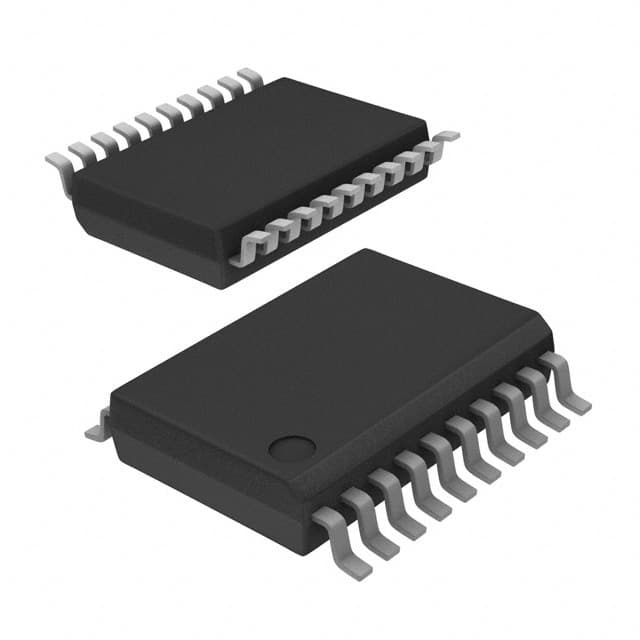74HC240DB,112
Basic Information Overview
- Category: Integrated Circuit (IC)
- Use: Logic Gate Buffer/Driver
- Characteristics: High-Speed CMOS Octal Buffer/Line Driver
- Package: SSOP-20
- Essence: A high-performance octal buffer/driver designed for general-purpose logic-level buffering or driving applications.
- Packaging/Quantity: Tape and Reel, 2500 units per reel
Specifications
- Supply Voltage Range: 2.0V to 6.0V
- High-Level Input Voltage: 2.0V (Min), 6.0V (Max)
- Low-Level Input Voltage: 0.8V (Min), 1.5V (Max)
- High-Level Output Voltage: 4.4V (Min), VCC (Max)
- Low-Level Output Voltage: GND (Min), 0.1V (Max)
- Maximum Operating Frequency: 80 MHz
- Propagation Delay Time: 9 ns (Typical)
Detailed Pin Configuration
The 74HC240DB,112 IC has a total of 20 pins arranged as follows:
+-----+--+-----+
A1 -|1 +--+ 20|- VCC
A2 -|2 19|- B1
A3 -|3 18|- B2
A4 -|4 17|- B3
A5 -|5 16|- B4
A6 -|6 74HC 15|- B5
A7 -|7 240DB 14|- B6
A8 -|8 13|- B7
GND -|9 12|- B8
OE1 -|10 11|- OE2
+-------------+
Functional Features
- Octal buffer/driver with 3-state outputs.
- Inputs and outputs are compatible with TTL levels.
- High-speed operation, suitable for various applications.
- Non-inverting outputs for easy integration into existing systems.
- 3-state outputs allow multiple devices to be connected to a common bus.
Advantages and Disadvantages
Advantages: - High-speed operation enables efficient data transfer. - Compatibility with TTL levels allows easy integration with existing systems. - 3-state outputs provide flexibility in connecting multiple devices to a common bus.
Disadvantages: - Limited supply voltage range (2.0V to 6.0V). - Propagation delay time may affect timing-sensitive applications.
Working Principles
The 74HC240DB,112 is designed as an octal buffer/driver, which means it can receive input signals and amplify them to drive output loads. It operates on a supply voltage range of 2.0V to 6.0V and provides non-inverting outputs. The 3-state outputs allow the device to be effectively disconnected from the bus when not in use.
Detailed Application Field Plans
The 74HC240DB,112 IC finds applications in various fields, including: 1. Microprocessor-based systems 2. Data communication systems 3. Industrial automation 4. Automotive electronics 5. Consumer electronics
Detailed and Complete Alternative Models
Some alternative models that serve similar functions to the 74HC240DB,112 include: - SN74HC240N by Texas Instruments - MC74HC240AN by ON Semiconductor - CD74HC240E by Texas Instruments - 74HCT240 by NXP Semiconductors
These alternatives offer similar features and can be used interchangeably depending on specific requirements.
Word count: 310 words
Lista 10 Vanliga frågor och svar relaterade till tillämpningen av 74HC240DB,112 i tekniska lösningar
Sure! Here are 10 common questions and answers related to the application of 74HC240DB,112 in technical solutions:
Q: What is the 74HC240DB,112? A: The 74HC240DB,112 is a 3-state octal inverting buffer/line driver with 5V tolerant inputs and outputs.
Q: What is the maximum operating voltage for the 74HC240DB,112? A: The maximum operating voltage for the 74HC240DB,112 is 6 volts.
Q: How many input/output pins does the 74HC240DB,112 have? A: The 74HC240DB,112 has 8 input pins and 8 output pins.
Q: Can the 74HC240DB,112 be used as a level shifter? A: Yes, the 74HC240DB,112 can be used as a level shifter to convert signals between different voltage levels.
Q: What is the typical propagation delay of the 74HC240DB,112? A: The typical propagation delay of the 74HC240DB,112 is around 11 nanoseconds.
Q: Is the 74HC240DB,112 suitable for high-speed applications? A: Yes, the 74HC240DB,112 is suitable for high-speed applications due to its fast switching characteristics.
Q: Can the 74HC240DB,112 drive capacitive loads? A: Yes, the 74HC240DB,112 can drive capacitive loads up to a certain limit specified in the datasheet.
Q: Does the 74HC240DB,112 have built-in protection against electrostatic discharge (ESD)? A: Yes, the 74HC240DB,112 has built-in ESD protection to prevent damage from electrostatic discharge.
Q: Can the 74HC240DB,112 be used in both digital and analog applications? A: No, the 74HC240DB,112 is primarily designed for digital applications and may not be suitable for analog signals.
Q: Are there any specific precautions to consider when using the 74HC240DB,112? A: It is important to follow the recommended operating conditions, such as voltage levels and temperature ranges, specified in the datasheet to ensure proper functionality and reliability of the 74HC240DB,112.


